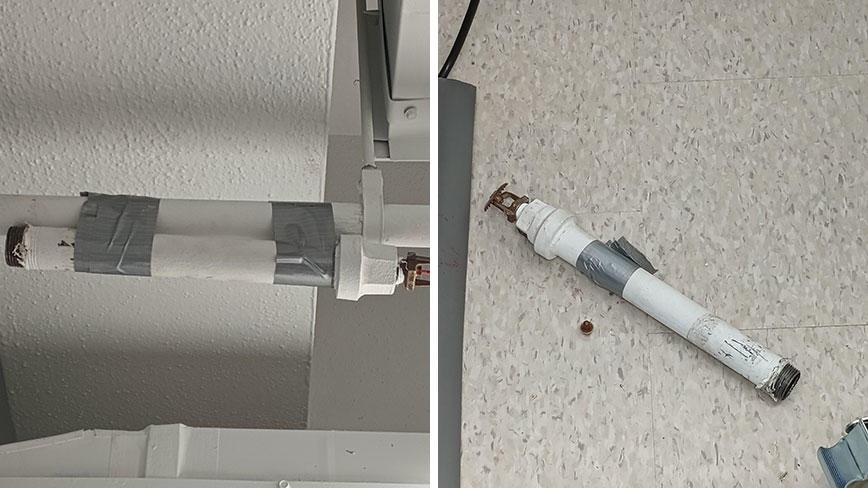More Than a Year of Renovations Takes a Toll on Researchers at Moffett Lab
For more than a year, Moffett Laboratory has been under renovation — virtually torn down and reconstructed — even as students, faculty, and staff have continued to work in the labs amid a series of disruptions.
Many of the scientists and researchers in Moffett are part of the Department of Ecology and Evolutionary Biology (EEB), and in the 2025-26 academic year, they’ll be housed in the brand-new Briger Hall in the Environmental Studies and School of Engineering and Applied Sciences (ES & SEAS) complex. But the year leading up to the EEB department’s move has been filled with interruptions that have jeopardized research, including a power outage that impacted freezers that stored samples and endangered live animals, according to Professor Bridgett VonHoldt.
“Over the past year, an ongoing project in Moffett to replace the stucco on the exterior façade, windows, and major mechanical ductwork for the building has been underway,” University spokesperson Ahmad Rizvi told PAW in an email. “This project will conclude late summer 2025. We are also working on an ongoing project to convert Moffett and Schultz from steam to hot water [for heating].”
Moffett, which was originally built in 1961, was last renovated in 2020. Rizvi also said that a renovation of Moffett’s third floor, slated to take place from fall 2025 through winter 2027, will serve the Department of Molecular Biology. At the same time, the building’s fume hood exhaust system will be replaced.
For months, VonHoldt has worked in a windowless Moffett office plagued with loud drilling noises. The office wasn’t always windowless — there’s a sizable area covered with tape, paper, and plastic covering what once was a view of Washington Road. The drilling is also supposed to stop by 10 a.m. so that Moffett can continue to be used for research and meetings.
Matthew Tomaszewski, vice provost for space programming and planning, sent an email in mid-March clarifying those guidelines, but two weeks later when PAW spoke with VonHoldt, crews continued to drill after 10 a.m.
VonHoldt told PAW she appreciates that Princeton’s resources have allowed them to renovate older structures and build new ones, but the impact of Moffett’s renovations on ongoing research has been deeply frustrating.
VonHoldt also said contractors and work crews have regularly told staff that individual projects would take a few weeks to complete, but new projects are always starting up.
“Little do they realize — and we soon find out — that while that three-week project is going on, somewhere in the middle, another three-week project starts with also noise or inconvenience or dust … . And no one has taken a moment to realize we’re just sitting here in what now feels like an insane asylum,” VonHoldt said.
According to Rizvi, some projects, including replacing ductwork, windows, and the exterior façade of a structure will “often take place throughout the year while staff and students are working inside the building.”
In mid-March, the fourth floor and part of the third floor flooded because, according to VonHoldt, construction workers did not adequately secure tarps on the roof. Water pooled in the tarps and spilled into the building.
“I have spent countless hours coordinating with the project team to make sure everything goes smoothly, facilitating their work,” Ishani Sinha, a senior research specialist for the Campbell-Stanton Lab, wrote to PAW in an email. “That’s not what I was hired to do, but it was necessary to minimize disruptions to our research. Trying to maintain the exceptional levels of productivity that’s expected of us in this elite institution while working in the middle of multiple active construction projects for nearly a year has been stressful, to say the least.”
In mid-April, a sprinkler pipe fell from the ceiling in Moffett into a lab space (no one was injured). Photos show duct tape used to secure it to another pipe.
“This does not feel very safe,” VonHoldt wrote in an email to Tomaszewski and Damon Pasquale, Princeton’s construction manager.
Sinha said that she understands the work that is being done is important.
“At the end of the day, they (the people on the project team) are good people, they’re just doing their jobs and their work is important,” she wrote. “But in this process, a huge burden was (perhaps inadvertently) placed on those of us who continue to work in the building. Doing research is hard enough as it is. I hope our side of the story helps make sure no one else on campus has this experience.”












1 Response
Donald R. Kirsch *78
5 Months AgoUpdating a No Frills Lab Building
Colin Pittendrigh was a biology department faculty member during the 1950s and ’60s. He also served on NIH study sections during that time. Back in those days, the NIH funded the construction of biomedical research buildings on university campuses (hard to image given the state of affairs today). Dr. Pittendrigh was annoyed that such projects commonly had large cost overruns. So when Princeton applied for NIH funding to build the Moffett labs, Dr. Pittendrigh wanted to be sure the project would be completed on budget. And it was. As a result there were no “frills,” such as good quality lab benches, cold rooms, vacuum and compressed air lines, fume hoods, central air conditioning for the building, etc., etc.
Work to address these and other deficiencies was initiated almost immediately and was being vigorously pursued when I was a graduate student in the 1970s. Obviously the work never stopped and is going on today. Hopefully the latest iteration, though inconvenient, will result in a permanent fix.